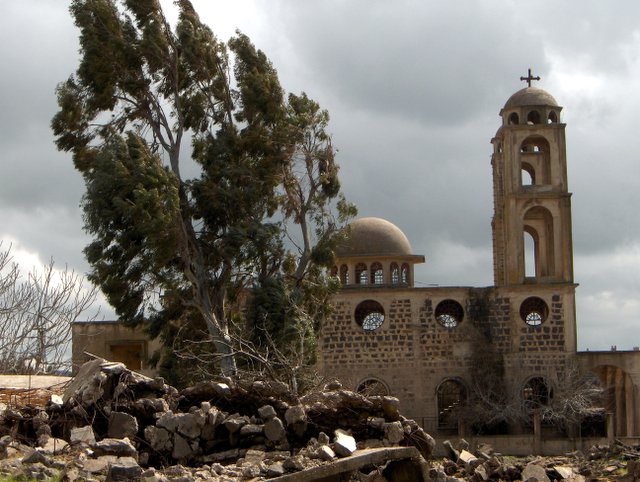Golan Heights is internationally known primarily due to its occupied status by Israel since the 1967 wars. With the time available to my visiting friends, we decided to visit and see with our own eyes the reality on the ground over what is internationally being debated. Hence the visit to this town in the Golan Heights called Quneitra. It is situated in southern Syria, bordering Lebanon, Jordan and Israel. One could only visit it by obtaining a special permit from the Ministry of the Interior. Got the necessary permit and off we went (me and a couple of friends visiting Syria) in two separate cars. The area that we visited now lies in the demilitarized United Nations Disengagement Observer Force (UNDOF) Zone between Syria and Israel, a short distance from the de facto border between the two countries. Quneitra lies undisturbed ever since, a ghost town riddled with land mines, an open-air museum of Middle-Eastern wars (Syria now shows it off as proof of Israeli malice). Church domes and minarets, blackened and broken, rise above the wasteland..
| read further....... | [−] |
Quneitra is indeed a gorgeous place to visit despite what had happened to it. However, I would not say that our group enjoyed the visit – how could one claimed to be enjoying walking through the bulldozed ruins of a once-normal town. Seeing the extent of destruction left behind by Israel, one could really sympathize with the feelings of those Syrians whose families come from the Golan and who cannot live there now. We were informed that families kept bringing the younger generations to visit their lands and what is left of their homes to keep the memories alive and continuous hopes of coming back to the land.
We left Quneitra with mixed emotions thinking how fortunate we as Malaysian has been and at the same time thinking of the suffering of the local Quneitrans and also those Syrians that are still living in the Occupied Golan Heights.
Descriptions of Quneitra by media reports in the past:
“Direct evidence of the city's condition was provided when it was filmed on 12 May 1974 by a British television news team which included the veteran journalist Peter Snow, who was reporting for Independent Television News on the disengagement negotiations. His report was broadcast on ITN's News at Ten programme. According to The Times' correspondent Edward Mortimer, "viewers were thus afforded a panoramic view of the city, which had stood almost completely empty since the Syrian army evacuated it in 1967. It could be seen that many of the buildings were damaged, but most of them were still standing." After it was handed over, "very few buildings were left standing. Most of those destroyed did not present the jagged outline and random heaps of rubble usually produced by artillery or aerial bombardment. The roofs lay flat on the ground, 'pancaked' in a manner which I am told can only be achieved by systematic dynamiting of the support walls inside." Mortimer concluded that the footage "establishes beyond reasonable doubt that much of the destruction took place after 12 May—at a time when there was no fighting anywhere near Quneitra”



We left Quneitra with mixed emotions thinking how fortunate we as Malaysian has been and at the same time thinking of the suffering of the local Quneitrans and also those Syrians that are still living in the Occupied Golan Heights.
Descriptions of Quneitra by media reports in the past:
“Direct evidence of the city's condition was provided when it was filmed on 12 May 1974 by a British television news team which included the veteran journalist Peter Snow, who was reporting for Independent Television News on the disengagement negotiations. His report was broadcast on ITN's News at Ten programme. According to The Times' correspondent Edward Mortimer, "viewers were thus afforded a panoramic view of the city, which had stood almost completely empty since the Syrian army evacuated it in 1967. It could be seen that many of the buildings were damaged, but most of them were still standing." After it was handed over, "very few buildings were left standing. Most of those destroyed did not present the jagged outline and random heaps of rubble usually produced by artillery or aerial bombardment. The roofs lay flat on the ground, 'pancaked' in a manner which I am told can only be achieved by systematic dynamiting of the support walls inside." Mortimer concluded that the footage "establishes beyond reasonable doubt that much of the destruction took place after 12 May—at a time when there was no fighting anywhere near Quneitra”
Some other pictures ..... trail of destruction!!

0 comments:
Post a Comment